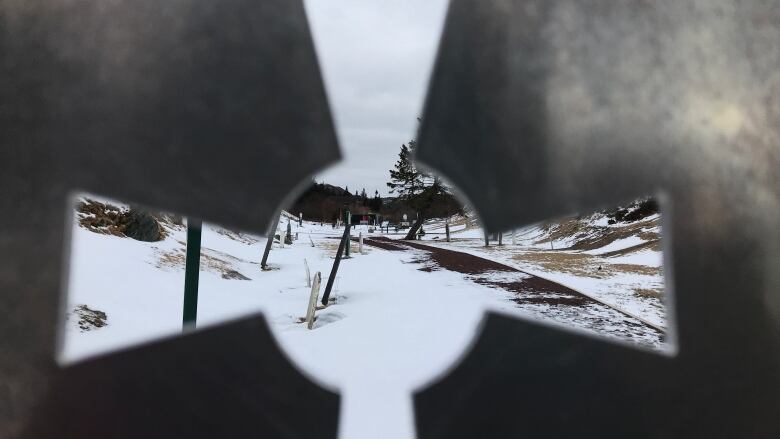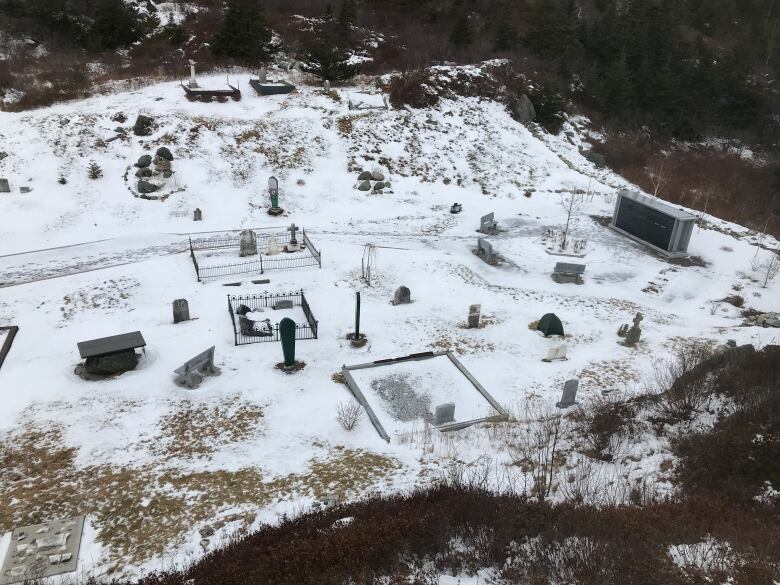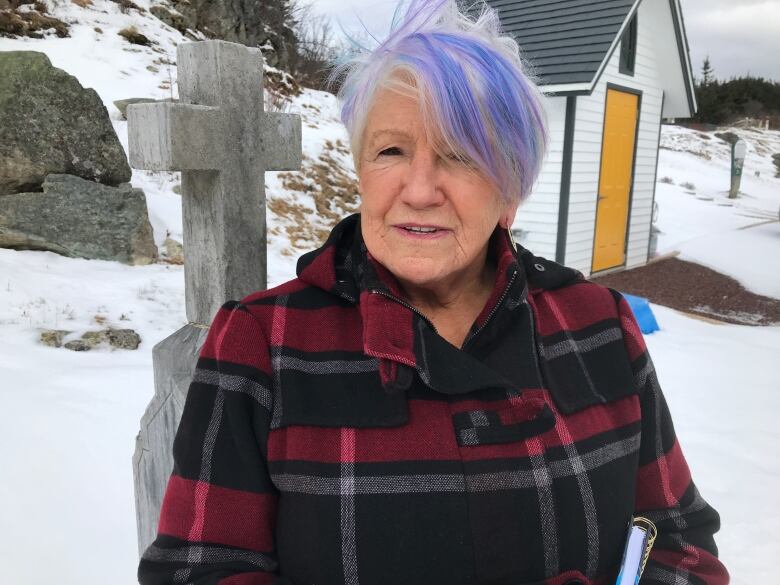How a church insolvency has interrupted a cemetery restoration project in Burin
Committee seeks legal advice after $200K seized by archdiocese, and worries mount over fate of hallowed ground

Locals call it the "old" St. Patrick's Roman Catholic cemetery, but an expensive and ambitious restoration project in recent years has dramatically transformed this hallowed ground on Seaview Drive in the town of Burin.
Itsancient grave markers, once hidden amid overgrown alders and creeping undergrowth, are once again exposed for all to see, part of a makeover that has seen the site transformed into a park-like setting, one that helps tell the story of a community with a history dating back to the early 1700s.
But this spiritual undertaking has been halted, money has been seized, and nerves are frayed.
Like so many church-owned properties in the Archdiocese of St. John's, the fate of the cemetery is now on shaky ground as lawyers, real estate agents, surveyors and others pick through the assets of a venerable institution that's been part of the province's social fabric for more than 200 years.

The courts have ruled that the archdiocese is vicariously liable for the abusesuffered by young boys who attended Mount Cashel orphanage in the '40s, '50s and '60s, and in order to satisfy what will undoubtedly be millions in claims by dozens of survivors, the archdiocesehas become insolvent.
The archdiocese, through its episcopal corporation,has a vast holding of properties, reaching all the way from St. John's to the southern tip of the Burin Peninsula, ranging from churches and rectories to schools and vacant land, and it's all for sale through a court-supervised process.
By all accounts, the church's physical presence in the region is expected to shrink dramatically this year as property is sold, churches close and parishes combine or disappear altogether.
What's less certain is the fate of the dozens of cemeteries included among that long list of holdings, and that hasput members of the cemetery restoration committee in Burin on edge.
Nobody is suggesting cemeteries will be disturbed by this process.- Geoff Budden
"The mortal remains of our grandparents, great-great-grandparents and so many relatives, are on the block. It's up for sale. All of our cemeteries are," said committee member Evelyn Grondin-Bailey.
But that might not be the case.
A list of tendered properties was revealed in a St. John's court Friday, and it did not include any cemeteries.
"I haven't heard anything so far in this process to suggest that the cemetery will be impacted by the insolvency," said Geoff Budden, the St. John's lawyer who represents about 70 Mount Cashel survivors.
"Nobody is suggesting cemeteries will be disturbed by this process," Budden added.
While they haven't received a formal commitment, cemetery committee members hope ownership of the property can be transferred to them for the sum of $1.
Archbishop Peter Hundt declined an interview request on Friday, but in a statement said an update on the insolvency will be provided this weekend to all parishes, and there are plans to speak publicly on Monday.

Meanwhile, the St. Patrick's cemetery had been neglected for decades, but a group dedicated to restoring some dignity to the final resting place for many of the town's founders pulled off a pre-pandemic miracle, and it came in the form of a chase the ace fundraiser that filled their bank account with $1.3 million.
The committee hired landscapers and funeral homes and other specialists, and at a cost of more than $500,000, created a cemetery that's become a destination for locals and visitors alike.

There are story boardsdetailing the history and traditions of the area, a teardrop monument dedicated to the memory of stillbornand miscarried children, and a new gravestone and fencing to mark the final resting place of six Catholic nuns who served and died in the area in the 1800s.
There's also a new lookout that offers a panoramic view of the cemetery, surrounding community and Burin Harbour.
But the centrepiece a new columbarium is at the back of the cemetery, which means that for the first time in more than 70 years, the cemetery can once again become a final resting place for area residents, not just Catholics.
A columbarium is a vertical, above-ground granite or marble structure normally found in cemeteries, and each structure contains a number of niches that hold urns containing cremated remains.
For several thousand dollars, families can place their loved ones inside the columbarium. In a few short years, nearly 20 niches are already occupied.
The footing is also in place to add two more columbariums, and it's this money-making opportunity that committee members worry may attract potential buyersand tempt those trying to raise as much money as possible for the abuse survivors.
That's where committee member Eugene Antle draws the line, because his son and other family members are inurned at the cemetery.
"It's very upsetting to to know that we went through all the trouble of putting our family members here and that we don't know what's going to happen," said Antle.
"Someone could move in, take this over and run it privately, and they could certainly make money on it, which is what we don't want."

When the archdiocese announced late last year it was seeking creditor protection, the shock waves reverberated throughout eastern Newfoundland, including in Burin.
The archdiocese issued a stop-work order to the cemetery committee, andannounced it was seizing all the cash reserves from each parish, which included some $200,000 in the cemetery committee's account.
That money had been set aside to complete a memorial wall for the cemetery, listing the names of deceased former residents of Burin, repair and restore some of the broken gravestones, and to establish a trust fund to ensure the cemetery would be maintained long after the current committee members passed on.
But that plan is now in limbo, and committee members are not happy.
While Evelyn Grondin-Bailey wants Mount Cashel survivors to be compensated for their suffering, she wonders if there's another way "without destroying everything that we hold dear to us."

The committee wants its $200,000 returnedand is consulting a lawyer to determine whether it has a legal leg to stand on.
She said the behaviour of Christian Brothers at Mount Cashel, and the refusal of church leaders to hold them accountable, is a betrayal of Catholics and the victims.
But, she said, the handling of the insolvency is also a betrayal: "We put our heart and soul in this.."
She wonders if the church can survive, and fears the end of Roman Catholicism as they know it.












_(720p).jpg)


 OFFICIAL HD MUSIC VIDEO.jpg)
.jpg)



























































































